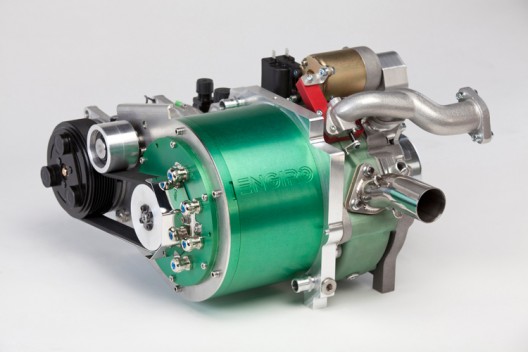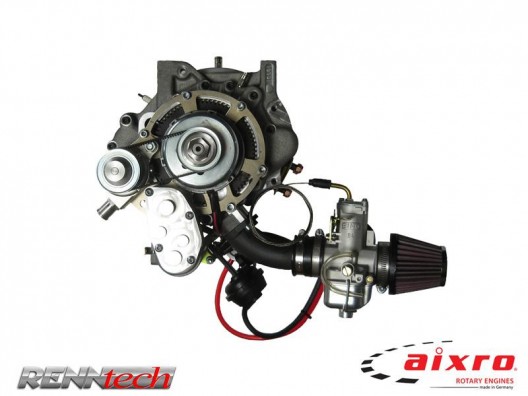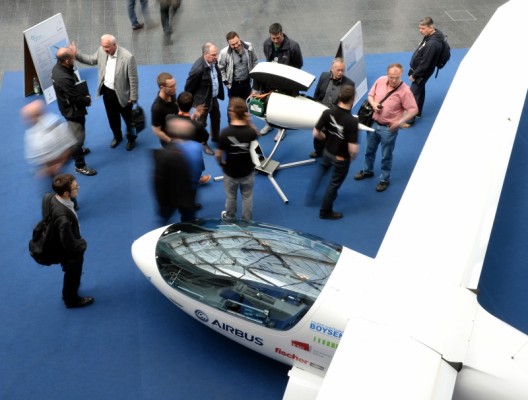Shown at the E-Flight Expo at Friedrichshafen’s Aero 2015, Stuttgart University’s e-Genius had an aerodynamic-looking pod next to one wing, containing an ENGIRO range extender consisting of a Wankel-type engine and a generator. The unit could, as its name implies, help e-Genius go for new records to add to its already significant collection.
Bill Lofton at EV Hangar has detailed the extender, now associated with the e-Genius and in a larger variant on the Equator P2 amphibian being built in Norway by Tomas Broedreskift.
Equator’s web site describes its power system: “The hybrid propulsion system being developed by Equator is called EHPS (Equator Hybrid Propulsion System). The engine specific project is being co-funded by Transnova and the company doing the development work with us on this is ENGIRO. We will design a custom engine and generator specified specifically for the P2. Power out in the prop is 100kW (approx. 130HP) and the generator will produce 57-60kW of power charging the batteries. The combustion engine will be a Wankel engine that runs on bio-diesel fuels and jet-fuel. The fuel tank can hold 100l and this should give you a flying time of 5-6 hrs. max.”

Engiro RE15-1 hybrid generator unit with Wankel engine on right, generator on left. 20 kW model is identical, but turns over faster
The version on the e-Genius is the smaller 20 kilowatt model, comprising an Aixro Wankel engine and “a permanent excited synchronous machine (most compact electrical machine)” generator. The demonstrated efficiency of e-Genius, having set seven world records in two days in July, 2014 with Klaus Ohlman at the controls, was reported by Soaring Café:
– Airspeed on a 100 kilometer out and return distance: 178.1 km/h (110.42 mph)
– Airspeed during 500 km out and return: 93.03 km/h (57.68 mph)
– Distance of 504 km (312.48 miles)
– Absolute altitude gain: 6,376 meters (20,918 feet)
– Time to climb up to 6000 m (19,685 feet) : 1 h 53 min
– Altitude kept during at least 90s: 6,350m (20,833 feet)
– Airspeed in a straight line of 15 km: 229.7 km/h (142.41 mph)
The extremely compact unit (said to fit on an A3 sheet of paper (420 mm x 297 mm, or 16.5 inches x 11.7 inches), weighs 32 kilograms (70.4 pounds). It generates 20 kilowatts (26.8 horsepower) of electrical output, with the four-stroke Wankel engine turning 6,000 rpm. According to the data sheet, the 294-cc engine consumes five liters per hour at an output of 15 kW.
Given the clean nature of e-Genius, having toured the Green Flight Challenge course in 2011 at a fuel economy equivalent to 387.3 passenger miles per gallon at over 100 mph, a range extender on less than full power would enable extremely long flights while recharging the airplane’s batteries, and maybe allow removal of some of the 300 kilograms (660 pounds) carried by e-Genius.
Even an expensive (the engine costs $5,450 minimum from an American supplier) range extender would cost less than several hundreds of pounds of lithium batteries, and the energy density of a non-fossil fuel would keep economies high.

The Aixro XF40 Wankel engine, a higher-speed, higher output version of the engine on the e-Genius hybrid pod. Unit puts out 35 horsepower at 6,500 rpm, weighs 41.2 pounds
RennTech Karting, a distributor in Florida, sells the Aixro engines, and even has an aeronautical version. It’s rare to see a manufacturer and distributor willing to take on the challenges of aerial applications, so this may have some potential for American homebuilt aircraft types to try their hand at creating a domestic hybrid.
(Editor’s Note: Howard Handelman, a friend of the blog, sends this long, but helpful addenda. You may notice he has opinions:
Since jet fuel / diesel is heavier than petrol, the same liters would weigh more and the SFC would be higher (worse). However, the 5 liters for 20 HP is based on petrol (benzine on the engine maker’s website). They have not, apparently, said how they will get past the notoriously thirsty nature of the Wankel style rotary.


Comments 1
Very encouraging! My personal opinion is that “range extenders” (APU?) are the critical stepping stone between today and an all-electric tomorrow.